
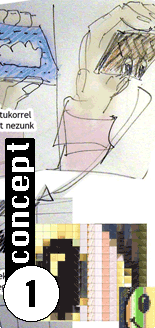
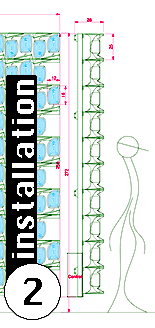
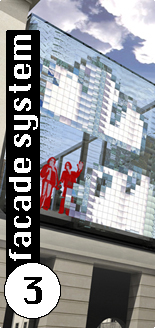
 |
› |
› |
› |

| Timeline ›› Opening 2007 May 4th ‹‹ Construction 2007 March ‹‹ Prototype testing 2007 January ‹‹ technological specification 2006 November ‹‹ site visit 2006 Aug ‹‹ Belsay hall competition won 2006 May ‹‹ entering a call for Juha Huskonnen curator 2006 April ‹‹ Honorary mention at heat of Budapest architectural competition 2006 Feb ‹‹ First blogs publish 2005 November |
| Concept Aleph is an experimental public display, that is using the spaces, people and objects it faces as a palette to display messages from hidden viewpoints. When looking at a small mirror, it reflects a fraction of the space around us, when looking at a mirror façade, it reflects most things around us, containing segments that are dark or bright, red or green. But if we build a matrix of small mirrors, which can adjust their tilt according to the site they are facing, we can create a display that uses the ever changing flux of the place to show images from certain points in space. 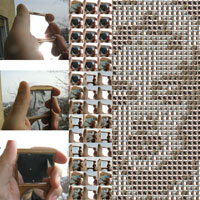 Concept
explaining collage This image is generated from
unedited photos using a mirror and tilting
it to reflect various brightness levels (see it large) Concept
explaining collage This image is generated from
unedited photos using a mirror and tilting
it to reflect various brightness levels (see it large)It will not be comprehendible from all viewpoints, just from specific ones, asking visitors to explore the space, or providing surprising flashes in a public setup that can stay around the edge of comprehension. We can for example limit this point to the height of a child, so whenever she or he looks at the mirror, drawings emerge from the reflections of the clouds, drawings that appear only for them, that adults will not be able to see. Technology A computer is using cameras to continuously analyze the surroundings, implement interaction and distribute targeting information to a network of microcontrollers positioning the mirrors. Processing (java) simulation Try this simulation: click on the image, press d and f to display and flatten images, press i to change images (mirror locations) The biggest challenge is developing the mechatronics for positioning the mirrors with precision and speed at a low cost which is essential in order to make a massive amount of mirrors. Several technologies are evaluated to find the one best suited. For example voice coil actuators, consisting of a wire loop and a permanent magnet, and solenoids might be the most effective way to move mirrors and are thoroughly investigated. |
About the name The name comes from a fictional point of singularity by Jorge Luis Borges: Aleph is a point in space that contains all other points. Anyone who gazes into it can see everything in the universe from every angle simultaneously, without distortion, overlapping or confusion. "Under the step, toward the right, I saw a small iridescent sphere of almost unbearable brightness. At first I thought it was spinning; then I realized that the movement was an illusion produced by the dizzying spectacles inside it. The Aleph was probably two or three centimeters in diameter, but universal space was contained within it, with no diminution in size. Each thing (the glass surface of a mirror, let us say) was infinite things, because I could clearly see it from every point in the cosmos. I saw the populous sea, saw dawn and dusk, saw the multitudes of the Americas, saw a silvery spiderweb at the center of a black pyramid, saw a broken labyrinth (it was London), saw endless eyes, all very close, studying themselves in me as though in a mirror, saw all the mirrors on the planet (and none of them reflecting me), saw in a rear courtyard on Calle Soler the same tiles I'd seen twenty years before in the entryway of a house on Fray Bentos, saw clusters of grapes, snow, tobacco, veins of metal, water vapor, saw convex equatorial deserts and their every grain of sand...." The Aleph, Jorge Luis Borges (source: wikipedia.org) |
| Installation |
About Belsay
Hall
There have been quite a few people and projects creating alternative displays, from room lights, to water drops, even we have been experimenting with rotating pixels before. Given all the above, once we had the idea in 2005 to use the colors reflected on moving mirrors from the environment to shuffle new information into the same data, we thought that we really would like build it. Not for technological innovation, nor for artistic novelty, but simply out of curiosity, and believing that whatever we build, we will anyhow take things forward. |
Facade
system 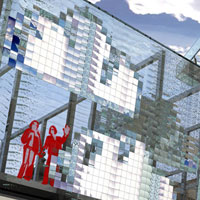 As
we see the concept as a great architectural element, we are continously
in discussion with possible partners
and architectural projects for this. Have a look at
this large
rendering
to see how we image aleph large scale. By tilting tiles of
glass
one could play with natural reflection and truly transparent areas,
something regular glass facades can't achieve. As
we see the concept as a great architectural element, we are continously
in discussion with possible partners
and architectural projects for this. Have a look at
this large
rendering
to see how we image aleph large scale. By tilting tiles of
glass
one could play with natural reflection and truly transparent areas,
something regular glass facades can't achieve.contact us if you are interested to learn more |
Notes In 2006 January we entered an architectural competition together with EEA Budapest, office, led by Judit Z Halmágyi, and András Kangyal, Anita Pozna and Barbara Sterk in our team. The illustration on the left is a product of this. We received honorary mention. |
|
Archives 2006 March   Videos of simulation using camera input, how this would feel with a changing environment aleph_02.mov and a video using simple image recognition to only displace the background and not the people in front aleph_mixedreality.mov 2005 December 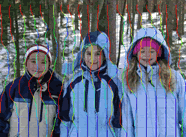 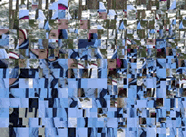 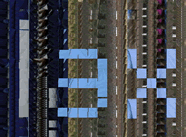 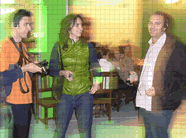 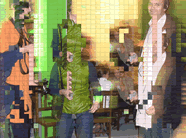 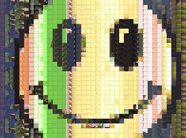
|